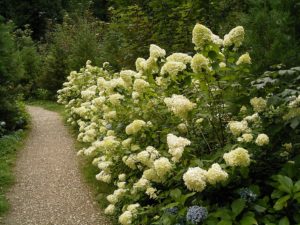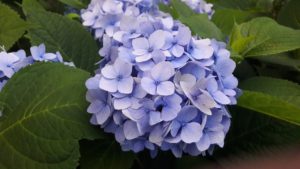All About Hydrangeas

This blog is all about those stunning Hydrangeas!
And – don’t worry! We are here to give you all the details on how to care for these beauties!
When designing your garden – and deciding which type of plant you like and would fit your space the best – it is ideal to get all the information about each one and go from there!
So, let’s check them out!
The six types of hydrangeas commonly grown in the United States are Bigleaf, Smooth, Panicle, Oakleaf, Climbing and Mountain.
Below we list the quick stats of how big the plant will grow and when they bloom. For more individual information click on the name of the plant.
The Bigleaf Hydrangea (Hydrangea macrophylla) can grow 6-10’ and bloom from June to October!
The Smooth Hydrangea (Hydrangea arborescens) can grow and spread out 3-5’ and bloom from June to September!
The Panicle Hydrangea (Hydrangea paniculate) can grow and spread out to be 6-12’ or 8-15’ and bloom from July to September!
The Oakleaf Hydrangea (Hydrangea quercifolia) can grow 6-8’ and bloom from July to September!
The Climbing Hydrangea (Hydrangea anomala ssp. petiolaris) can grow 30-40’ (yes, you read that correctly) or 5-6’ if grown upright. They bloom from May to July!
The Mountain Hydrangea (Hydrangea serrata) will grow 2-4’ and bloom from June to August!
Hydrangeas grow in full sun or part sun exposure. They grow will in any soil and a wide range of zones but will grow best with an acidic to neutral soil pH balance, according to the Farmer’s Almanac.
Additionally, hydrangeas like moist soil but they will die quickly if waterlogged for weeks. Meaning if the soil has a good drainage system, the plants will grow well.
When planting multiple hydrangea shrubs, it is important to remember to plant each shrub at least 3-10’ apart from each other so they have space to grow. For the first couple of years after planting a new shrub – and during a summer drought – it is important that hydrangeas are well watered. Lorraine Ballato, who wrote Success With Hydrangeas: A Gardner’s Guide, reports that hydrangeas that are in a mulched landscape will conserve water longer then those planted in a landscape that is not mulched.
Fertilizing hydrangeas will depend on your soil type. If you have rich soil you do not need to fertilize the plant. However, if you have sandy soil is it recommended to fertilize in the late winter or early spring.
There is a wide array of colors that hydrangeas can come in – blue, green, purple, red, pink, and white! Many times, one shrub will have multiple colored flowers! The fun pops of color are eye catching and they make a great backdrop for other plants in your garden.
Hydrangeas not only add color to your outdoor space but once blooming, clip a few and use them to brighten your indoor space as well!
If you want to add hydrangeas to your garden, give us a call (717-285-2750) or click here and we can get the planting scheduled for this Fall or early Spring so they are ready to bloom next season!









Leave a Reply